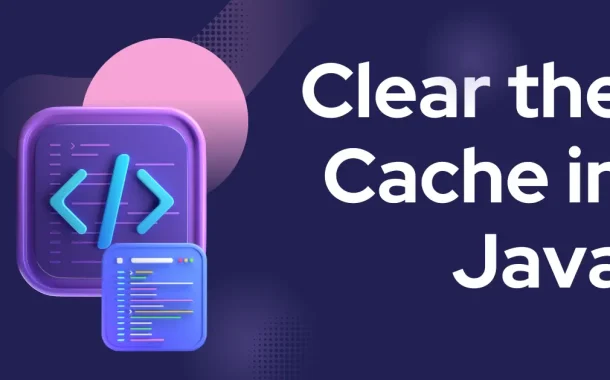Caches help speed up your computer by saving time looking for things that it’s already seen before. They’re like little helpers making sure everything runs smoothly without you even noticing. Caches are like fast-access memory that helps your computer work faster and more efficiently.
Table of Contents
Table of Contents
What is Cache in Java
In Java, a cache is a special storage area where frequently accessed data is kept temporarily. It’s like having a handy drawer next to your desk where you keep the books or papers you use most often. When a Java program needs specific information, it first checks the cache instead of searching for it every time. If the data is already there, the program can grab it quickly without the hassle of finding it elsewhere. This process helps speed up the program’s performance because it saves time that would otherwise be spent retrieving data from slower sources like databases or the internet.
Caches in Java are incredibly helpful for improving the efficiency of applications. Imagine you’re using a web browser, and you visit a website multiple times a day. Instead of downloading all the website’s data every time you visit, the browser stores some of it in its cache. So, when you return to the site, the browser can load it much faster because it already has some of the necessary information stored locally. This caching mechanism makes browsing the internet smoother and more enjoyable.
Java caches come in different forms and sizes, depending on the needs of the application. Some caches store data in memory, which is super fast to access but limited in size. Others may store data on a disk, which is slower but can hold more information. Regardless of the type, the goal remains the same: to optimize performance by reducing the time it takes to access frequently used data.
Types of Caches in Java
In Java, there are several types of caches commonly used to improve the performance of applications.
In-Memory Caches
In Java, an in-memory cache is like a super-fast storage area where frequently used data is kept temporarily. It’s like having a quick-access shelf right next to your desk where you keep your most-used books or papers. When a Java program needs specific information, it checks this cache first to see if it’s already there. If the data is in the cache, the program can grab it lightning-fast without having to look for it elsewhere, which makes things run much quicker.
This type of cache is perfect for storing things that are needed often and need to be retrieved quickly. For example, in a Java application, you might use an in-memory cache to store objects, results of complex calculations, or data fetched from a database that’s accessed frequently. By keeping this data in memory, the program doesn’t have to go through the slower process of fetching it from disk or over the internet every time it’s needed.
Disk-Based Caches
Disk-based caches in Java work similarly to in-memory caches, but instead of storing data in the computer’s random-access memory (RAM), they store it on the hard disk or other persistent storage devices. It’s like having a big storage cabinet where you keep things that you don’t need to access as often but still want to have nearby.
While accessing data from disk is slower than accessing it from memory, disk-based caches can hold much larger amounts of data. They’re ideal for storing files, images, or other resources that might be too large to fit entirely in memory. For example, a Java application might use a disk-based cache to store user-uploaded files, historical data, or cached web pages.
Disk-based caches are especially useful when dealing with large datasets or resources that need to be persisted across application restarts. By storing data on disk, Java applications can conserve memory and improve overall system performance.
Distributed Caches
In Java, distributed caches are like a team of storage areas spread across multiple computers or servers, working together to store and retrieve data. Each storage area, or node, holds a portion of the cached data, making it available to the entire network. It’s like having a group of friends who each keep a piece of the puzzle, and when you need the complete picture, they all come together to help.
Distributed caches are commonly used in large-scale applications or systems where data needs to be shared and accessed by multiple users or components simultaneously. They help improve scalability, reliability, and performance by distributing the workload across multiple nodes. For example, in a distributed e-commerce platform, each server might cache product information locally to reduce the load on the central database and improve response times for users.
By distributing cached data across multiple nodes, Java applications can handle higher volumes of traffic, tolerate failures more gracefully, and scale more efficiently as the demand grows.
Query Caches
In Java, query caches are like a memory bank specifically for storing the results of database queries. When a Java application executes a database query, the results are stored in the query cache temporarily. If the same query is executed again with identical parameters, the application can retrieve the results from the cache instead of re-executing the query, saving time and resources.
Query caches are particularly useful in scenarios where database queries are repetitive or involve complex computations. By caching the results of frequently executed queries, Java applications can reduce the load on the database server and improve overall performance. It’s like having a notebook where you write down the answers to math problems so you can look them up quickly instead of doing the calculations again.
Web Caches
In Java, web caches are like intermediaries between web servers and clients, such as web browsers. When a client requests a web resource, such as a webpage or an image, the web cache intercepts the request and checks if it has a copy of the requested resource stored locally. If the resource is found in the cache and is still fresh (i.e., it hasn’t expired), the cache serves it directly to the client without needing to fetch it from the original server.
Web caches help improve the performance of web applications by reducing latency, conserving bandwidth, and offloading traffic from origin servers. They store commonly accessed web resources, like HTML pages, CSS stylesheets, JavaScript files, and images, making them readily available to clients. This process is akin to having a library where frequently read books are kept on hand for immediate access without having to wait for them to be checked out or delivered.
Why Clearing the Cache is Necessary?
Clearing the cache is necessary for a few reasons.
- Data Accuracy: Sometimes, the cached data gets old, and if we don’t clear it, users might see outdated information, which can confuse them.
- Managing Memory: Caches use up memory space, and if we let them fill up too much, it can slow down the system or even crash it. Clearing the cache helps free up memory for other important tasks.
- Boosting Performance: If the cached data isn’t needed anymore or if it’s slowing things down, clearing it can help the system run faster and smoother.
- Security Measures: Cached data might contain sensitive information, so clearing it regularly helps keep that information safe from prying eyes or hackers.
- Troubleshooting: When we’re trying to figure out why something isn’t working right, clearing the cache can help us see if the issue is related to old or incorrect data being stored.
Methods to Clear Cache in Java
There are several methods to clear cache in Java.
Programmatic cache
Programmatic cache clearing in Java means using special tools provided by caching libraries to manage cached data. These tools include simple commands to remove specific cache entries or clear the entire cache altogether.
For example, if our application updates or deletes a piece of data, we can use these commands to make sure the corresponding cached data is also updated or removed. It’s like having a remote control to tidy up a messy room – we can target specific items or clear everything out with just a few clicks.
Alternatively, developers can create custom ways to manage cache in their Java applications. This gives them more control and flexibility in deciding when and how to clear the cache based on their specific needs and preferences. Programmatic cache clearing offers a convenient and efficient way to keep cached data organized and up-to-date, ensuring smooth performance for Java applications.
Manual Cache Clearing
Manual cache clearing involves directly removing cache entries or cache files from the system without relying on automated tools. For disk-based caches or caches that store data in files, developers can manually delete cache files or directories to clear the cache.
It’s like cleaning out a drawer by hand – we go in and remove specific items or clear out the entire drawer to make space for new things. This method requires caution to avoid accidentally deleting important data or causing disruptions to the application.
Developers may need to implement mechanisms to ensure that cache-clearing operations are performed safely and efficiently. While manual cache clearing offers direct control over cache management, it may be more labor-intensive and error-prone compared to automated approaches. Manual cache clearing can be effective for clearing specific cache entries or addressing cache-related issues in Java applications.
Cache Expiration Policies
Cache expiration policies dictate when cached data should be considered stale and automatically invalidated or removed from the cache. One common expiration policy is time-based expiration, where cache entries are assigned a specific lifespan or time-to-live (TTL).
For example, developers can configure the cache to automatically expire entries after a certain duration, such as 10 minutes or 1 hour. This ensures that cached data remains fresh and up-to-date, reducing the risk of serving stale information to users.
Another expiration policy is usage-based expiration, where cache entries are invalidated based on their access patterns or usage frequency. For instance, developers can configure the cache to remove entries that haven’t been accessed for a certain period or limit the number of times an entry can be accessed before it’s invalidated.
Cache Eviction Strategie
Cache eviction strategies determine how cache entries are selected for removal when the cache reaches its capacity limit. One common eviction strategy is the Least Recently Used (LRU) strategy, where the least recently accessed cache entries are evicted first.
Imagine a library where the least borrowed books are removed to make space for new arrivals. Another strategy is the First-In-First-Out (FIFO) strategy, where the oldest cache entries are evicted first, similar to a queue where the first item added is the first to be removed.
Developers can choose the most suitable eviction strategy based on the access patterns and requirements of their Java application. Each eviction strategy has its trade-offs in terms of cache efficiency and performance. It’s essential to evaluate and select the strategy that best meets the application’s needs.
Practices for Cache Management
Firstly, make sure to update or remove cached data when the original data changes, keeping everything consistent. Next, set rules for how long cached data should stay valid, so it doesn’t become outdated. You can decide based on time or how often the data is used.
Keep an eye on how well the cache is working by checking how often data is found in the cache compared to how often it’s requested. Choose the best way to decide which data gets removed from the cache when it gets full. For example, you might remove data that hasn’t been used recently or data that was added first.
Have a backup plan for when the data someone needs isn’t in the cache. This could mean getting the data from somewhere else or generating it again if needed. Make sure the cache isn’t taking up too much memory or too little. It should be just the right size for your application’s needs. Test how well the cache performs under different situations to make sure it can handle the workload effectively.
Conclusion
Managing cache in Java is essential for keeping applications running smoothly. By using methods like clearing cache programmatically or manually, setting expiration policies, and choosing eviction strategies, developers can maintain data accuracy and system performance. Following best practices such as monitoring cache usage, testing performance, and documenting decisions ensures effective cache management.
Ultimately, these efforts help prevent issues like outdated data or memory overload, ensuring optimal performance and user satisfaction. By implementing these simple yet crucial steps, Java developers can keep their applications running efficiently and provide a better experience for users.














